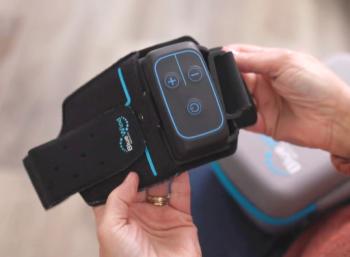
Telehealth: How physicians can get started now
Tabassum Salam, MD, the ACP's vice president of medical education, discusses what physicians need to know to get started with telehealth right away.
Physicians need telehealth to keep their practices afloat and to treat their patients during the COVID-19 pandemic. Tabassum Salam, MD, the ACP's vice president of medical education, discusses what physicians need to know to get started right away.
Below is a transcript of the interview with Salam, edited for clarity:
Medical Economics: How do you define telehealth? What is the best working definition for physicians for telehealth?
Tabassum Salam, MD: So there's a lot of definitions being used out there - telehealth telemedicine - so sometimes the terms get used interchangeably and it can be a little bit confusing. So I think, in general, what you'll find is telehealth is the broader umbrella term. It refers to using electronic communications methods to deliver health care to patients. Telehealth being the broader term encompasses telemedicine, which we'll talk about in a second. There’s mHealth which, for example, is a way to deliver health information to patients, as well as remote patient monitoring, which is the way to record biologic measures at home and deliver them to a physician who might make an intervention based on them. The term telemedicine, in particular, is usually reserved to refer to synchronous and asynchronous direct patient care delivery. When you say synchronous, most people refer to video conferencing between, say a physician and his or her patient.
Medical Economics: In the context of the COVID-19 pandemic, can you discuss the ways physicians will be using telehealth twith their patients?
Salam: Certainly. We're in an unfortunate situation with the National Health Emergency due to the Coronavirus pandemic. But physicians can feel substantially reassured that they can still provide access to their patients by utilizing telemedicine and that many patients are able to use these services. It brings them a lot of relief to be able to connect with their regular doctor. It's great because patients aren't allowed to get out and about it's safer for them to stay at home. And likewise do it for their physicians. It's safer for them to stay at home too, but to be able to continue to give them care. Patients can access their physicians through telemedicine for acute concerns.
Certainly right now, many people are worried about themselves with respect to coronavirus so they can get their questions answered, have some symptoms discussed and get some sort of triage assessment as to whether they need to escalate the need for care to in person care. But certainly one has to remember that their care for ongoing chronic diseases shouldn't be abandoned either. And this is a great opportunity for the regular physicians, primary care and subspecialty physicians to use telemedicine to continue to give them guidance on how to manage chronic diseases, for example, diabetes, high blood pressure, common ones that they don't stop needing care and these emergency situations.
Medical Economics: The federal government and the states are loosening regulations on telehealth. Can you talk through just I know that they're very rapidly changing?
Salam: There are several categories and you're right, they're evolving almost daily, but some broad generalizations that start with licensure. Several states have relaxed the requirement that a physician or other a few other categories of healthcare providers must be wet licensed in their state to provide care to patients residing in their state. It is at a state level so every practitioner is advised to check the state requires.
Another big advantage in this period is an overall ease in the rigidity of choosing a telemedicine platform that is strictly HIPAA compliant. You don't want to throw caution to the wind, you do definitely want to keep patient security and cyber security in mind when you're choosing a platform with which to reach out to your patient. But at least right now, if you're a physician or practice hoping to get started in a emergency manner, you're able to choose more commonplace solutions like Zoom, or Skype, which you weren't able to do before this emergency.
In addition, several payers including Medicare have relaxed requirements concerning patient location. Prior to this emergency, for example, Medicare patients had to be in certain locations such as physician offices, or if they were to receive telemedicine care from home they had to live in rural areas. Several of those requirements have been reduced, making it very feasible for physicians and patients in rural urban or other areas to reach out to each other and use telemedicine for their care. And several reimbursement relaxations have happened meaning that the spectrum of types of care and types of patients to whom care can be given has grown, which has made it feasible for more physicians and practices to introduce telemedicine in their everyday care of their patients.
Medical Economics: What advice do you have for physicians that are using telehealth now, and looking ahead to a time when the regulations tighten back up and practices re-open to patients in person. What advice do you have to help them navigate that transition?
Salam: Well, I'd say the biggest thing that we should take away from this is that many physicians and patients have taken the leap across that barrier into telemedicine and both sides are realizing this is very feasible and has so many positive aspects that it brings to their delivery and receipt of healthcare. I would like to see that enthusiasm carry over as we emerge back into more of a state of normalcy. And I would like to hear those voices raised to advocate for making telemedicine a wonderful asset in the way that we deliver healthcare in America. It will never replace the need and importance of in person care. But it's a wonderful ancillary method in which to extend our reach to our patients, either because of geography, or the dimension of time, and the inconvenience that in person visits might sometimes create. So I'd really like to hear the voices and energy of physicians and other health care providers, patients, and payers joined in unison to make this a more standard part of American healthcare going forward.
Medical Economics: Many physicians were using telehealth before COVID-19, but there's a number that were not. So can you kind of give a basic crash course in what you need to do to start from ground zero and build a telehealth program from scratch and really quickly?
Salam: Since so many regulations have been eased, now's a great time to jump in. The first thing you want to do, as a practice leader, physician leader in a practice, is gather your team, make sure that you, your fellow physicians, other health care providers, and your administrative team are on board, because everyone's going to need to participate to make this happen.
Next, work out a workflow with your office staff. Have them work with you to brainstorm the easiest way to switch your typical work flow to introduce telemedicine. There are some natural areas in which the transition is easiest.
For example, sit down and script out a message that your receptionist can use when patients are calling in that they can use to invite patients to make the switch to telemedicine, words that are reassuring and will let the patient know that you will be there to support them, especially about the technical transition so they feel comfortable making the change.
Talk to your scheduling staff about how you want to adjust your calendar. Usually it's a small matter of just adding perhaps the the letters tm to the end of a patient's name on the schedule so everyone knows that's a telemedicine visit.
You will want to choose a telemedicine platform. And in this emergency period when many of the HIPAA regulations have been eased, perhaps you should choose a simple platform. Just go with commercial Zoom. Go with Skype. If you would like to look into some of the formal telemedicine vendors, you can. They will show you the easiest way to get started.
And then you will want to get the message out to your patients that you are up and running on telemedicine. Obviously, when patients call in to inquire about receiving care, your staff is ready to tell them.
You should sit down with your staff and look at a list of the patients that have been scheduled for visits in the coming months. Call each of those patients one by one and tell them that you don't want to cancel the visit, you want to convert it to tell them that In addition, you should create an easy “how to” guide for your patients - how they should log on, how they should configure their web cam. If we're going to be using a webcam, remind them that they should choose a quiet, private, secure location from which to engage in the visit so that they are able to maintain their privacy. Reassure them that, just in case the video conferencing aspect doesn't quite work out, there's always good old fashioned telephone and that both sides can revert to that if they need to, and still get a lot of care delivered.
Medical Economics: We should physicians do to help patients who do not necessarily feel comfortable with technology? Is there a role for, you know, families or caregivers in this kind of exchange?
Salam: We have an overwhelming sense of responsibility to make sure that we can give fair and equitable access to health care to everybody. Every physician will tell you that they're very concerned that the video conferencing platform might just be a step too far for many of their patients.
The first thing I want to caution everyone about though is to make no assumptions. It's amazing how tech savvy all of us have become, certainly in the last month. So many of us have pushed our boundaries and been pleasantly surprised by how much more we're able to accomplish. Many times I hear the concern that perhaps an older patient may not be able to utilize a video conferencing platform. But I personally have been very humbled by the sheer number of patients of any age group who are using videoconferencing very well. So ask your patient. If they are using FaceTime to check in with their own loved ones, then they're probably set. If they have a smartphone, they are probably going to be able to make the transition comfortably.
And as you mentioned, if they haven't quite made the jump themselves, this is a great time for them to reach out to family or other local support, who might be able to pop over and configure their device for the platform that you're choosing for the medical care. And in the end, just reassure patients in the this for the small fashion for whom none of this will be feasible. There is still the telephone.
Medical Economics: What's the role for physicians versus the role for non-physician providers, such as a physician assistants or nurse practitioners, in telemedicine? Can you kind of talk through that a little bit?
Salam: The bottom line is everyone can do a consultation via telemedicine. I think a big part of what we're discussing is which health care providers care are reimbursable. It does vary by payer, but there's been a lot of relaxation and extension in this the last few weeks. So I encourage every practice to look into their various payer types and investigate where the options for reimbursement have been extended.
It is wonderful to be able to include multiple members of an interprofessional team in the care of your patients, just as you might do in the office where you, for example, have your nurse practitioner come in, or substitute for a physician for several visits, where nurses play an integral role in patient education, where perhaps a nurse case manager or social worker steps in to support patients with many of their social needs. There's no reason why that should stop. It just needs to be managed through the video conferencing platform where you can bring in the other members of your team to complement the clinical leaders in any interaction.
Medical Economics: If your practice wants to jump to hiring a professional, third-party telehealth vendor, what are the benefits of that? And what are some of the “buyer beware” things you need to look out for?
Salam: There are many vendors out there and most of them have much of the same basic attributes that are necessary for telemedicine.
I think a good starting point is to get a sense of the customer service available to you. Certainly, as a practice choosing a vendor, you want to make sure that you are introduced to the various aspects of the solution in an easy to understand way.
Understand what it will take to get set up, and how long it will take to get set up. What technical requirements are needed on your end? Is your internet capability up to par for what they need for their solution to run well? Understand what kind of customer service you can expect to receive for troubleshooting, for your practice and of the platform, as well as maybe for your patients. Are they available to patients get ready to roll on the platform?
Ask about HIPAA compliance. If you're going to pay for a vendor, I think it's obvious that you want to make sure you've chosen a HIPAA compliant vendor. Ask for a Business Associate Agreement with your vendor to make sure that they join with you in taking responsibility for security and privacy with the patient's interactions.
Very important: Ask about the cost structure. How are you going to be paying for the use of this platform? You do need to need to factor that into expenses. You will be hopefully cutting down on traditional overhead expenses, such as rent or perhaps the cost of staff if you're converting a substantial chunk of your patient interactions to telemedicine. You want to make sure, though, that the cost of that platform is balanced with it's benefit for your practice.
And finally, a good question to ask is around integration with your existing EHR. Is it feasible with the platform that you're about to choose? There are some that are natural built-ins, and so learn the facts about that and the realities of the ease of doing that.
Medical Economics: Are there any other things that we haven't discussed about getting started with telehealth that you think it's important for physicians to know about?
Salam: I think the biggest misconception that physicians think there is not much patient demand for telemedicine. I don't think that's true anymore. And another is that the technical hurdles are insurmountable. I think we're finding rapidly that that's also not the case. And I think the final misconception is that reimbursement lags. Certainly now, during the public health emergency, it's become necessary for many practices to make the jump in order to continue to have a stream of revenue, and that many peers have indeed relaxed and extended the types of visits that they reimburse. So all I can say is, it's an unfortunate time to find ourselves in a pandemic situation, but we shouldn't lose connection to our patients and we should jump in and use telemedicine to do so.
Newsletter
Stay informed and empowered with Medical Economics enewsletter, delivering expert insights, financial strategies, practice management tips and technology trends — tailored for today’s physicians.














